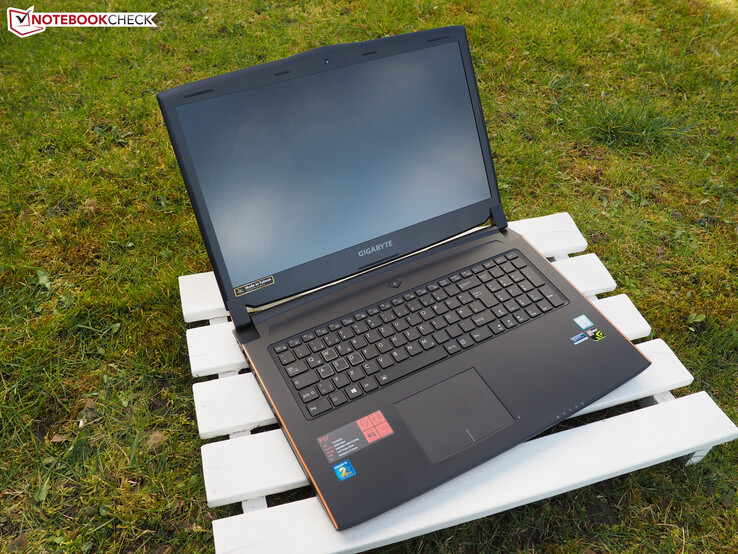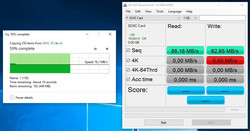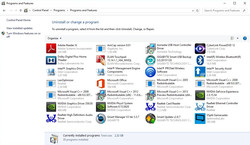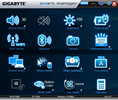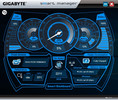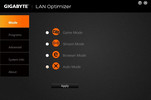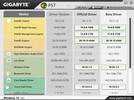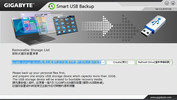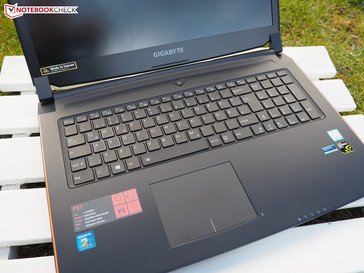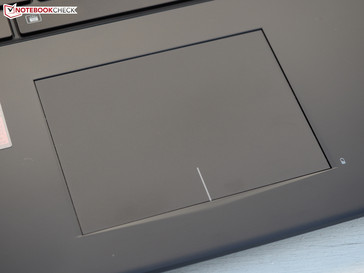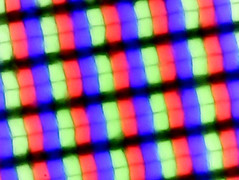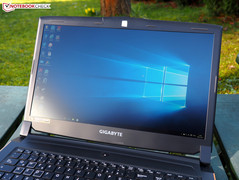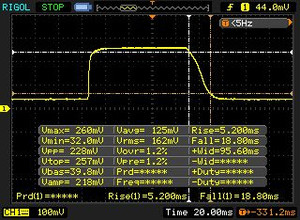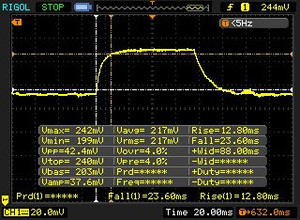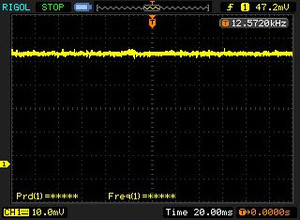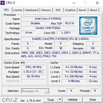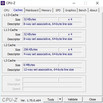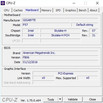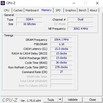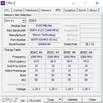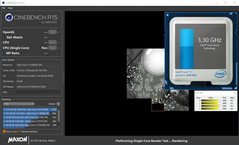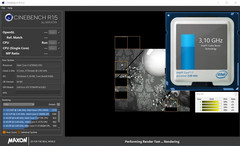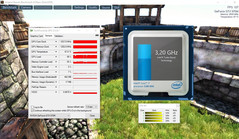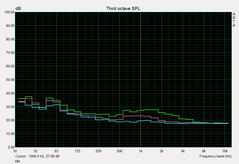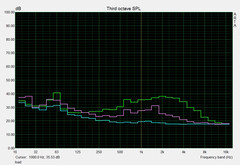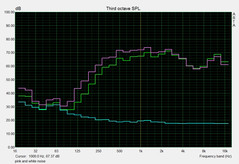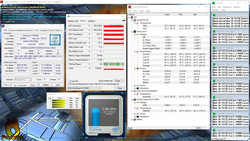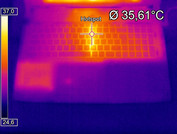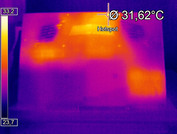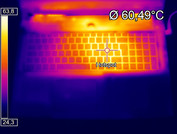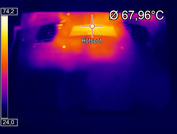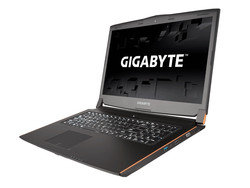Gigabyte P57W Notebook Review
For the original German review, see here.
While there is already the fifth revision of the 15-inch P55W sibling available (see review), the P57W is completely new to the market. Gigabyte did not take many risks. In the gaming segment, a quad-core processor from Intel's Skylake generation (Core i7-6700HQ) is currently as common as a high-end GPU with Nvidia's Maxwell architecture (GeForce GTX 970M). 16 GB of DDR4 RAM and a Full HD IPS panel are also now practically obligatory. The same is true for the combination of SSD and HDD. Currently, the P57W costs just under 1700 Euros (~$1934). However, the new model is hard to find in German online shops.
The main competitors include similarly fast and expensive 17-inch gamers like the Acer Predator 17, the Alienware 17 R3, the Asus G752, the MSI GS70, or the Schenker XMG P706. Alternatives from the same manufacturer are the P37X v5 and the Aorus X7 Pro v5.
Case
Alike most manufacturers Gigabyte uses a black plastic chassis, which is made less monotonous with orange lines on the sides. With a height of 2.5 cm, it is quite slim for a gaming notebook.
Despite the slim build, the stability of the base unit is relatively good. However, the lid could be stiffer. It can be easily warped and depressed with the hands. The build quality is not absolutely perfect, either. Especially the joint of the display frame and lid is slightly imprecise in our test model. But, the keyboard lines up much more precisely with the palm rests than we often saw in Gigabyte notebooks in the past.
In terms of quality, the chassis appears to be decent. If you ignore creaking noises when warping the display, you cannot complain. The hinges allow opening the 17-incher with one hand. The display does not wobble too heavily on vibrating surfaces.
Connectivity
Interfaces
Apart from the USB 3.1 port (Type C without Thunderbolt), the connectivity is not striking. While the left side houses two USB 3.0 ports, an RJ45 port, a card reader, two audio jacks (microphone + headphones), and a Kensington security lock slot, the right side provides power-in, another USB 3.0 port, and as many as three video-outs (VGA, HDMI 2.0 & Mini-DisplayPort). In our opinion, the biggest highlight is the replaceable drive bay on the front side, which either houses a DVD or Blu-ray burner or a 2.5-inch hard drive.
Card reader
The SD-card reader achieves average results. Just under 86 MB/s in sequential reading and 76 MB/s in moving jpg files are neither good nor especially bad compared to the competition. In theory, our Toshiba Exceria Pro SDXC 64 GB UHS-II reference card is able to reach up to 260 MB/s. However, only very few notebooks can achieve this.
Wireless Communication
The Intel Wireless-AC 8260 adapter provides wireless connections to the Internet. Apart from Bluetooth 4.2, it also supports the WLAN standards 802.11 a/b/g/n/ac. Its range was good in the individual test setup of the author. It could even connect to the router in a distance of 10 to 15 meters and through several walls. Windows showed 2 out of 5 bars and 40-50 Mbit/s on average.
Maintenance
Although the P57W does not have a maintenance hatch, buyers can upgrade components and clean the cooling system. Once you loosened 16(!) screws the underside can be easily removed. You can get to the two fans and also to the Wi-Fi module, the storage devices (1x M.2 PCIe + 1x 2.5 inch), two DDR4 RAM slots and the screwed battery. As so often, graphics card and processor are soldered to the motherboard and cannot be replaced.
Software
The laptop scores points with the handy tools preinstalled from Gigabyte. While Smart Update helps in updating drivers, the LAN Optimizer deals with network traffic. Programs for creating recovery media (Smart USB Backup) and system monitoring (Smart Dashboard) are also not a bad thing.
The Smart Manager is noteworthy, since it is the primary place to go. It provides many handy functions, some of which can also be triggered by key combinations (volume, brightness, webcam, etc.). Advanced users can also adapt fan control and display colors. Our display tests are based on the standard setting Native Color. We selected the most suitable fan option for each scenario (Quiet for idle, Gaming for Load) in Fan Tweak.
Accessories
A warranty card, a driver DVD, a multi-lingual user guide, and an empty mounting frame, which can be incorporated instead of the DVD burner, are included. The 15.5 x 7.5 x 3 cm big power adapter weighs in at 638 g. The notebook itself weighs 3.16 kg, which is alright in view of the performance.
Warranty
The manufacturer's warranty is two years.
Input Devices
Keyboard
Basically, the keyboard is good. Although pressure point, stroke, and typing noise cannot completely keep up with premium gaming laptops' (e.g. the Alienware 17 R3), most buyers should be satisfied with its performance. Thanks to a standard layout, you'll get used to the keyboard quickly. Only the combined Ins/Del key was slightly annoying. The short travel is a matter of taste.
The dedicated number block, the good key size (15 x 15 mm), and the two-level keyboard light are praiseworthy. Since the keyboard is relatively far back, you'll get big palm rests, which even provide enough space for large hands.
Touchpad
We did not like the touchpad that much. First of all, it lacks stability especially on the left side, which reduces its value. On the other hand, it often registers wrong inputs when using multi-touch gestures (zooming, scrolling, etc.), since the mouse pointer tends to move with them. In general, ClickPads are not known for maximum precision and reliability. Drag and drop usually works better on conventional touchpads with dedicated buttons.
The size is good. 10.5 x 8 cm is usual for 17-inch devices. Mouse replacement and palm rests are hardly distinguishable by haptics. The surface is similarly smooth and so are the gliding traits.
Display
We already know the used display type. The LG Philips LP173WF4-SPF1 (do not confuse it with the SPD1) is used in lots of 17-inch notebooks, for example the Acer Predator 17 or the Gigabyte P37X v5.
| |||||||||||||||||||||||||
Brightness Distribution: 87 %
Center on Battery: 286 cd/m²
Contrast: 923:1 (Black: 0.31 cd/m²)
ΔE ColorChecker Calman: 4.49 | ∀{0.5-29.43 Ø4.78}
ΔE Greyscale Calman: 4.76 | ∀{0.09-98 Ø5}
84% sRGB (Argyll 1.6.3 3D)
55% AdobeRGB 1998 (Argyll 1.6.3 3D)
61.7% AdobeRGB 1998 (Argyll 3D)
84.4% sRGB (Argyll 3D)
66.5% Display P3 (Argyll 3D)
Gamma: 2.47
CCT: 6843 K
| Gigabyte P57W LG Philips LP173WF4-SPF1 (LGD0469) | MSI GS70-6QE16H21 Chi Mei N173HGE-E11 (CMN1735) | Acer Predator 17 G9-791-75PV LP173WF4-SPF1 (LGD0469) | Gigabyte P37X v5 LP173WF4-SPF1 (LGD0469) | Schenker XMG P706 LG LP173WF4-SPD1 | Alienware 17 R3 (A17-9935) CV69H_173WF4 (LGD0459) | |
|---|---|---|---|---|---|---|
| Display | 9% | 0% | 1% | 0% | 0% | |
| Display P3 Coverage (%) | 66.5 | 67 1% | 66.7 0% | 67.4 1% | 66.9 1% | 66.9 1% |
| sRGB Coverage (%) | 84.4 | 97.3 15% | 84.7 0% | 85 1% | 84.6 0% | 83.9 -1% |
| AdobeRGB 1998 Coverage (%) | 61.7 | 67.6 10% | 62 0% | 62.2 1% | 61.8 0% | 61.4 0% |
| Response Times | 9% | -15% | 8% | |||
| Response Time Grey 50% / Grey 80% * (ms) | 37 ? | 37 ? -0% | 45 ? -22% | 33 ? 11% | ||
| Response Time Black / White * (ms) | 24 ? | 20 ? 17% | 26 ? -8% | 23 ? 4% | ||
| PWM Frequency (Hz) | ||||||
| Screen | 4% | -1% | 3% | 1% | -2% | |
| Brightness middle (cd/m²) | 286 | 172 -40% | 337 18% | 306 7% | 306 7% | 360 26% |
| Brightness (cd/m²) | 274 | 161 -41% | 303 11% | 294 7% | 302 10% | 336 23% |
| Brightness Distribution (%) | 87 | 85 -2% | 85 -2% | 89 2% | 90 3% | 90 3% |
| Black Level * (cd/m²) | 0.31 | 0.26 16% | 0.26 16% | 0.42 -35% | 0.34 -10% | 0.44 -42% |
| Contrast (:1) | 923 | 662 -28% | 1296 40% | 729 -21% | 900 -2% | 818 -11% |
| Colorchecker dE 2000 * | 4.49 | 2.06 54% | 5.92 -32% | 3.51 22% | 5.49 -22% | 4.76 -6% |
| Colorchecker dE 2000 max. * | 7.83 | 8.39 -7% | 10.8 -38% | |||
| Greyscale dE 2000 * | 4.76 | 2.42 49% | 7.55 -59% | 2.23 53% | 3.97 17% | 3.69 22% |
| Gamma | 2.47 89% | 2.45 90% | 2.42 91% | 2.51 88% | 2.15 102% | 2.24 98% |
| CCT | 6843 95% | 6855 95% | 7270 89% | 6346 102% | 6163 105% | 6091 107% |
| Color Space (Percent of AdobeRGB 1998) (%) | 55 | 62 13% | 56 2% | 56 2% | 55.5 1% | 55 0% |
| Color Space (Percent of sRGB) (%) | 84 | 97 15% | 85 1% | 85 1% | 84.5 1% | 84 0% |
| Total Average (Program / Settings) | 7% /
5% | 3% /
1% | -4% /
0% | 1% /
1% | 2% /
-1% |
* ... smaller is better
This is not surprising due to its great image quality - at least in the aspects important for gamers. For example, the panel achieves a brightness of 274 cd/m², a black value of 0.31 cd/m², and a contrast of about 920:1. Well, many competitors perform a bit better here, but you can hardly see differences. In case you are concerned about the inferior brightness distribution (87 %): Don't panic, the test model showed very even images without backlight bleeding.
The P57W has not been designed for professional users with photo or video ambitions. As a typical gaming laptop, it slightly lacks color-space coverage (84% sRGB, 55% AdobeRGB) and color precision. While calibration improves the grayscales a lot, the DeltaE2000 shift remained above 3 (maximum of 8 for yellow and orange colors).
Gamers can safely ignore these weaknesses. Videos and other entertainment media are displayed flawlessly. Response time and viewing-angle stability are ordinary. As you might expect from an expensive laptop, it uses IPS instead of TN technology.
Display Response Times
| ↔ Response Time Black to White | ||
|---|---|---|
| 24 ms ... rise ↗ and fall ↘ combined | ↗ 5 ms rise | |
| ↘ 19 ms fall | ||
| The screen shows good response rates in our tests, but may be too slow for competitive gamers. In comparison, all tested devices range from 0.1 (minimum) to 240 (maximum) ms. » 53 % of all devices are better. This means that the measured response time is worse than the average of all tested devices (20.2 ms). | ||
| ↔ Response Time 50% Grey to 80% Grey | ||
| 37 ms ... rise ↗ and fall ↘ combined | ↗ 13 ms rise | |
| ↘ 24 ms fall | ||
| The screen shows slow response rates in our tests and will be unsatisfactory for gamers. In comparison, all tested devices range from 0.165 (minimum) to 636 (maximum) ms. » 52 % of all devices are better. This means that the measured response time is worse than the average of all tested devices (31.6 ms). | ||
Screen Flickering / PWM (Pulse-Width Modulation)
| Screen flickering / PWM not detected | |||
In comparison: 53 % of all tested devices do not use PWM to dim the display. If PWM was detected, an average of 8111 (minimum: 5 - maximum: 343500) Hz was measured. | |||
Performance
The P57W follows the current trend in connectivity as well as hardware. A combination from Intel CPU and Nvidia GPU, 8-16 GB of RAM, and a Solid State Drive with preinstalled Windows 10 Home 64-bit are typical for high-end notebooks.
Processor
The Core i7-6700HQ is the standard quad-core processor for laptops of around 1000 Euros (~$1138). Gigabyte handles the 14 nm Skylake chip well (TDP: 45 Watt). A maximum of 3.5 GHz in single-core applications and 3.1 GHz in multi-core applications match the limit specified by Intel.
The CPU cannot use its full Turbo potential only under full load. The clock rate falls to about 2.9 GHz, with short drops to 800 MHz. However, our tests prove that you do not have to bother about throttling during everyday tasks.
Cinebench R15 and Cinebench R11.5 confirm that the performance of the P57W is on par with the 6700HQ competition (see table). More powerful CPUs like the Core i7-6820HK do not really pay off, since they only achieve slightly higher scores. Note: On battery, the Core i7-6700HQ clocks between 2.6 and 3.2 GHz in the benchmarks.
System Performance
The system performance complies with other Skylake-based high-end notebooks. With 5955 points, the P57W performs even slightly better than the Alienware 17 R3 with GeForce GTX 980M and NVME SSD in PCMark 7. The MSI GS70 6QE and the Gigabyte P37X v5 are beaten, too. The Acer Predator 17 and the Schenker XMG P706 are minimally better on paper. In practice, all systems respond very quickly and you can hardly notice differences.
| PCMark 7 Score | 5955 points | |
| PCMark 8 Home Score Accelerated v2 | 3946 points | |
| PCMark 8 Creative Score Accelerated v2 | 4754 points | |
| PCMark 8 Work Score Accelerated v2 | 4935 points | |
Help | ||
| PCMark 7 - Score | |
| Schenker XMG P706 | |
| Acer Predator 17 G9-791-75PV | |
| Gigabyte P57W | |
| Alienware 17 R3 (A17-9935) | |
| MSI GS70-6QE16H21 | |
| Gigabyte P37X v5 | |
| PCMark 8 | |
| Home Score Accelerated v2 | |
| Gigabyte P37X v5 | |
| MSI GS70-6QE16H21 | |
| Schenker XMG P706 | |
| Gigabyte P57W | |
| Acer Predator 17 G9-791-75PV | |
| Creative Score Accelerated v2 | |
| Gigabyte P37X v5 | |
| Schenker XMG P706 | |
| MSI GS70-6QE16H21 | |
| Acer Predator 17 G9-791-75PV | |
| Gigabyte P57W | |
| Work Score Accelerated v2 | |
| Gigabyte P37X v5 | |
| MSI GS70-6QE16H21 | |
| Schenker XMG P706 | |
| Gigabyte P57W | |
Storage Devices
Although there is a trend towards PCIe SSDs, Gigabyte incorporated a conventional Solid State Drive with SATA III interface. Thus it is limited to 500-550 MB/s in sequential tasks. The 256 GB Lite-On L8T-256L9G of the P57W achieves a maximum of 486 MB/s (Read @AS SSD Benchmark) and 406 MB/s (Write), which is sufficient for almost all application scenario. The gap to PCIe models is much smaller with small files. So, most users will not face disadvantages here. It is annoying that the free M.2 slot is functionless.
As secondary storage device there is a 2.5-inch HDD on board. The HGST Travelstar 7K1000 works at 7200 rpm and features a capacity of 1000 GB. The SATA III model achieves up to 147 MB/s in sequential reading and 138 MB/s in sequential writing in CrystalDiskMark - very good results for an HDD.
| Gigabyte P57W Lite-On IT L8T-256L9G | MSI GS70-6QE16H21 Toshiba HG6 THNSNJ256G8NU | Acer Predator 17 G9-791-75PV Lite-On CV1-8B256 | Gigabyte P37X v5 Samsung SM951 MZVPV256HDGL m.2 PCI-e | Schenker XMG P706 Samsung SM951 MZHPV512HDGL m.2 PCI-e | Alienware 17 R3 (A17-9935) Samsung PM951 NVMe 512 GB | |
|---|---|---|---|---|---|---|
| AS SSD | -24% | -25% | 151% | |||
| Seq Read (MB/s) | 486.7 | 501 3% | 483.6 -1% | 1863 283% | ||
| Seq Write (MB/s) | 406.2 | 109.7 -73% | 332.9 -18% | 1273 213% | ||
| 4K Read (MB/s) | 28.77 | 20.85 -28% | 15.09 -48% | 39.93 39% | ||
| 4K Write (MB/s) | 55.5 | 55 -1% | 33.45 -40% | 95.3 72% | ||
| Score Total (Points) | 911 | 718 -21% | 769 -16% | 2278 150% |
Graphics Card
After the GeForce GTX 980 and the GeForce GTX 980M, the GeForce GTX 970M is the third-fastest notebook GPU from Nvidia. The high-end chip contains 1280 shaders and clocks at 924 to 1038 GHz during 3D load. According to the Unigine Heaven 4.0 benchmark, the Turbo can be kept up. The only exception is our stress test with the Furmark and Prime95 tools, which, however, is not very realistic. Here, the clock rate sometimes falls below the standard value.
Otherwise, the DirectX 12 model boasts 3 GB of GDDR5 VRAM and a 192-bit interface. However, it has to be mentioned that several manufacturers equip the GTX 970M with 6 instead of 3 GB of VRAM. Several games (e.g. Call of Duty Black Ops 3, Rise of the Tomb Raider & Hitman) require at least 4 GB for maximum settings and/or resolutions from FHD.
| 3DMark 11 Performance | 9363 points | |
| 3DMark Ice Storm Standard Score | 86161 points | |
| 3DMark Cloud Gate Standard Score | 21461 points | |
| 3DMark Fire Strike Score | 6619 points | |
Help | ||
The VRAM capacity has hardly an impact on synthetic graphics benchmarks like 3DMark 13. With a Fire Strike score of 6619 points, the P57W ranks in between the GTX 970M competitors MSI GS70 and Acer Predator 17. Notebooks with a GTX 980M are 25% faster on average.
| 3DMark | |
| 1920x1080 Fire Strike Score | |
| Schenker XMG P706 | |
| Gigabyte P37X v5 | |
| Alienware 17 R3 (A17-9935) | |
| Acer Predator 17 G9-791-75PV | |
| Gigabyte P57W | |
| MSI GS70-6QE16H21 | |
| 1920x1080 Fire Strike Graphics | |
| Schenker XMG P706 | |
| Gigabyte P37X v5 | |
| Alienware 17 R3 (A17-9935) | |
| Acer Predator 17 G9-791-75PV | |
| Gigabyte P57W | |
| MSI GS70-6QE16H21 | |
Gaming Performance
Apart from the extremely demanding ultra presets of Assassin's Creed Syndicate and XCOM 2 (which we continue to test with 8x MSAA even after the patch), the GTX 970M is mostly fast enough to run current games in native Full HD resolution with (very) high details and anti aliasing. Those who do not want to play games below 40 fps at maximum settings should choose a notebook with a GTX 980M or GTX 980.
| low | med. | high | ultra | |
|---|---|---|---|---|
| Call of Duty: Black Ops 3 (2015) | 96.7 | 94.9 | 57.5 | 50.8 |
| Assassin's Creed Syndicate (2015) | 79.9 | 73.8 | 47.9 | 19.4 |
| Rise of the Tomb Raider (2016) | 107.1 | 76.8 | 46.3 | 37.6 |
| XCOM 2 (2016) | 88.9 | 54.3 | 35.7 | 16.5 |
| Far Cry Primal (2016) | 94 | 56 | 49 | 35 |
| The Division (2016) | 117.2 | 87.6 | 43.9 | 33.6 |
| Hitman 2016 (2016) | 61.6 | 58.6 | 33.6 | 31.7 |
| Need for Speed 2016 (2016) | 95.7 | 89.8 | 57.8 | 44.4 |
Emissions
System Noise
The emissions show that the cooling system is appropriate. Although the P57W gets quite hot and loud under full load, it is still cooler and quieter than many competitors. While the MSI GS70 6QE reaches 42-52 dB (44-49 dB @Acer Predator 17) in 3D mode, the Gigabyte reaches "only" 37-47 dB. Top: The fans only slowly speed up under load and slow down quickly afterwards.
While idle, the laptop hardly gets loud. We felt that about 32-33 dB is decent. The 37 dB listed in the table only applies to booting. Unlike some devices, the P57W fortunately does not increase the fan speed sporadically without reason. The HDD is usually quieter than the fans. It only generates a quiet clattering noise when it is accessed heavily.
Noise level
| Idle |
| 32 / 33 / 37 dB(A) |
| HDD |
| 33 dB(A) |
| DVD |
| 38 / dB(A) |
| Load |
| 37 / 47 dB(A) |
 | ||
30 dB silent 40 dB(A) audible 50 dB(A) loud |
||
min: | ||
| Gigabyte P57W GeForce GTX 970M, 6700HQ | MSI GS70-6QE16H21 GeForce GTX 970M, 6700HQ | Acer Predator 17 G9-791-75PV GeForce GTX 970M, 6700HQ | Gigabyte P37X v5 GeForce GTX 980M, 6700HQ | Schenker XMG P706 GeForce GTX 980M, 6820HK | Alienware 17 R3 (A17-9935) GeForce GTX 980M, 6700HQ | |
|---|---|---|---|---|---|---|
| Noise | -3% | -5% | -3% | 3% | 1% | |
| off / environment * (dB) | 30 | 30 -0% | ||||
| Idle Minimum * (dB) | 32 | 30.8 4% | 32 -0% | 32 -0% | 30.9 3% | 31 3% |
| Idle Average * (dB) | 33 | 31.2 5% | 33 -0% | 34 -3% | 31.2 5% | 32 3% |
| Idle Maximum * (dB) | 37 | 36.6 1% | 37 -0% | 36 3% | 31.2 16% | 33 11% |
| Load Average * (dB) | 37 | 41.8 -13% | 44 -19% | 40 -8% | 40.5 -9% | 38 -3% |
| Load Maximum * (dB) | 47 | 53 -13% | 49 -4% | 51 -9% | 47 -0% | 50 -6% |
* ... smaller is better
Temperature
We especially liked the cool palm rests. Regardless whether idle or during the stress test, the front third of the notebook never exceeded 30 °C. While idle the whole chassis has a pleasant temperature. An average of 27 °C is an excellent value. After 60 minutes of full load, the case reached up to 55 °C, which is acceptable compared to the competitors.
Moreover, the components do not get hotter as in other 17-inch gaming laptops. Our stress test caused a GPU temperature of 78 °C and a CPU temperature of just under 90 °C.
(-) The maximum temperature on the upper side is 55.1 °C / 131 F, compared to the average of 40.4 °C / 105 F, ranging from 21.2 to 68.8 °C for the class Gaming.
(-) The bottom heats up to a maximum of 55.2 °C / 131 F, compared to the average of 43.3 °C / 110 F
(+) In idle usage, the average temperature for the upper side is 26.8 °C / 80 F, compared to the device average of 33.9 °C / 93 F.
(+) The palmrests and touchpad are cooler than skin temperature with a maximum of 29.8 °C / 85.6 F and are therefore cool to the touch.
(±) The average temperature of the palmrest area of similar devices was 28.9 °C / 84 F (-0.9 °C / -1.6 F).
| Gigabyte P57W GeForce GTX 970M, 6700HQ | MSI GS70-6QE16H21 GeForce GTX 970M, 6700HQ | Acer Predator 17 G9-791-75PV GeForce GTX 970M, 6700HQ | Gigabyte P37X v5 GeForce GTX 980M, 6700HQ | Schenker XMG P706 GeForce GTX 980M, 6820HK | Alienware 17 R3 (A17-9935) GeForce GTX 980M, 6700HQ | |
|---|---|---|---|---|---|---|
| Heat | -17% | 17% | -9% | 8% | -3% | |
| Maximum Upper Side * (°C) | 55.1 | 53.8 2% | 41.7 24% | 52.7 4% | 44 20% | 51.1 7% |
| Maximum Bottom * (°C) | 55.2 | 65.4 -18% | 41.6 25% | 70 -27% | 42.3 23% | 53.2 4% |
| Idle Upper Side * (°C) | 30.8 | 36.3 -18% | 27.2 12% | 30.9 -0% | 31.7 -3% | 31.7 -3% |
| Idle Bottom * (°C) | 27.1 | 36.3 -34% | 25 8% | 31 -14% | 29.9 -10% | 32.2 -19% |
* ... smaller is better
Speakers
The sound is worse than should be possible. Many buyers would expect higher quality for 1700 Euros (~$1934). Despite the Dolby Digital Plus audio software, videos, games, and music do not sound very precise. Volume and bass could also be better. The 17-inch sibling Aorus X7 Pro v5 performs significantly better with its four speakers and two subwoofers. Therefore, we recommend using an external sound system or a headset. The 2.0 system of the P57W does not give pleasure in the long run.
Energy Management
Power Consumption
Thanks to Nvidia's Optimus technology (only activates the GeForce GTX 970M during 3D tasks) the power consumption is quite low while idle. 11-22 Watt exactly matches the results of the Acer Predator 17. Under load the P57W requires 85 Watt (3DMark06) on average and a maximum of 178 Watt (stress test). Thus, the included 180-Watt PSU is not overloaded.
| Off / Standby | |
| Idle | |
| Load |
|
Key:
min: | |
| Gigabyte P57W GeForce GTX 970M, 6700HQ | MSI GS70-6QE16H21 GeForce GTX 970M, 6700HQ | Acer Predator 17 G9-791-75PV GeForce GTX 970M, 6700HQ | Gigabyte P37X v5 GeForce GTX 980M, 6700HQ | Schenker XMG P706 GeForce GTX 980M, 6820HK | Alienware 17 R3 (A17-9935) GeForce GTX 980M, 6700HQ | |
|---|---|---|---|---|---|---|
| Power Consumption | -20% | -1% | -26% | -7% | -10% | |
| Idle Minimum * (Watt) | 11 | 16.5 -50% | 11 -0% | 16 -45% | 12 -9% | 12 -9% |
| Idle Average * (Watt) | 17 | 23.1 -36% | 17 -0% | 21 -24% | 17.9 -5% | 18 -6% |
| Idle Maximum * (Watt) | 22 | 26.1 -19% | 22 -0% | 28 -27% | 19.3 12% | 26 -18% |
| Load Average * (Watt) | 85 | 95.8 -13% | 96 -13% | 96 -13% | 97.7 -15% | 95 -12% |
| Load Maximum * (Watt) | 178 | 146.4 18% | 164 8% | 215 -21% | 213 -20% | 188 -6% |
* ... smaller is better
Battery Life
While gaming notebooks could not work miracles in terms of battery runtimes in the past, they are able to reach acceptable results nowadays (graphics switch). Under ideal conditions, the P57W lasts almost 8 hours without the power adapter. Just under 5.5 hours during web surfing via Wi-Fi and 5 hours video playback at medium brightness are also not bad. As usual, the battery capacity is only sufficient for 1-1.5 hours of gaming. The GPU performance falls by about 25% on battery (Fire Strike test @3DMark 13).
| Gigabyte P57W 75.81 Wh | MSI GS70-6QE16H21 56 Wh | Acer Predator 17 G9-791-75PV Wh | Gigabyte P37X v5 76 Wh | Schenker XMG P706 60 Wh | Alienware 17 R3 (A17-9935) 92 Wh | |
|---|---|---|---|---|---|---|
| Battery runtime | -44% | 30% | -7% | -25% | 34% | |
| Reader / Idle (h) | 7.7 | 4 -48% | 11.7 52% | 6.4 -17% | 5 -35% | 12.6 64% |
| H.264 (h) | 4.9 | 2.6 -47% | 7.6 55% | 5.6 14% | 3.7 -24% | |
| WiFi v1.3 (h) | 5.6 | 3 -46% | 6 7% | 4.2 -25% | 3.7 -34% | 7.4 32% |
| Load (h) | 1.7 | 1.1 -35% | 1.8 6% | 1.7 0% | 1.6 -6% | 1.8 6% |
Pros
Cons
Verdict
At a first glance, you could think the Gigabyte P57W was a bigger variant of the P55W v5. This impression is actually true in most aspects, but there are some adaptations. For example, the 17-incher scores points with a better interface layout and rear-facing fans.
Moreover, there is a replaceable drive bay and the battery has a higher capacity (75 vs. 61 Wh), which, however, compensates for the slightly higher power consumption. Temperature and system noise are comparable, although the P57W is marginally better.
Apart from the subpar ClickPad, the 17-incher does not need to hide behind the competition. Looks, display, connectivity, and emissions are up-to-date. The same is true for the performance, which heavily profits from the Solid State Drive and the modern CPU and GPU. However, Gigabyte should improve the sound.
All things considered, the P57W proves to be a good high-end notebook, which can stand up to the MSI GS70, the Acer Predator 17, and the Schenker XMG P706. The partly significantly bulkier 17-inch gamers Alienware 17 R3, Asus G752 and MSI GT72S could achieve slightly higher ratings - regardless of the graphics cards.
Gigabyte P57W
- 04/18/2016 v5.1 (old)
Florian Glaser





